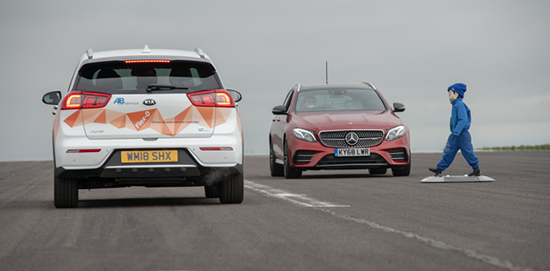On October 25, the American Center for Mobility hosted a live demo day as part of the Autonomous Vehicle Technology Expo, Automotive Testing Expo, and Autonomous Vehicle Test and Development Symposium. Attendees had an opportunity to see some of the best and latest AV testing technology put through its paces at one of North America’s toughest proving grounds. ACM’s extensive facilities include a 2.5-mile highway loop, a 700ft curved tunnel, a six-by-six intersection, and two double overpasses incorporating public and private roadways.
Here are some photos and video footage from the day.

AB Dynamics demonstrated an integrated range of tools for ADAS and AV testing with two automated driving tests: an AEB test using AB Dynamics’ by-wire controlled Flex-0 vehicle, along with a pilotable platform LaunchPad, to represent vulnerable road users; and a higher-speed ‘cut-in’ test using the company’s Guided Soft Target (GST) vehicle and three other vehicles.

AVL demonstrated its AVL-DRIVE Autonomous vehicle assessment system on a production Tesla Model 3 at the ACM as part of the Live Demo Day. The in-vehicle demonstration showed participants a live view of the AVL-DRIVE Autonomous system in operation and provided an overview of the depth of data and analysis that it can gather. In addition, an interference vehicle showed system response to cut-in events.

Humanetics and S-E-A demonstrated a range of ADAS evaluation and ADS development tools using ultraflat overrunable robots, automated test drivers, and vision detection systems. Live demonstrations will extend beyond AEB tests to show how complex scenarios can be created with strikeable targets (GVTs, VRUs, etc) for ADS development.

Keysight demonstrated a number of validation technologies, including how to test a vehicle’s connectivity (2/3/4/5G, V2X, wi-fi, Bluetooth) in a repeatable environment, while simulating the vehicle in a live network and in a congested environment. Its solution can iterate environmental variables such as weather, angle of arrival, interference, and fading, to augment track environments. It will also demonstrate its Radar Target Simulation (RTS) capabilities, which enable a system to undergo a quick check to verify each sensor is performing as expected. Providing a calibrated reference offers certainty when taking a vehicle on track. It can also enable some interesting testing involving interferers, which has been identified as critical from OEM down to chipset manufacturer. Keysight also profiled the latest version of PenTester, supporting cellular, Bluetooth, and wi-fi attack surfaces.

Moshon Data, which supplies the official Euro NCAP Vehicle Target (EVT) through to its own, cost-effective vehicle target, foam targets, and custom targets, demonstrated a realistic ‘Soft City Scape’ environment for vehicle testing and development. While many miles of AV testing is conducted on real roads, there is still a very real need to introduce vehicle sensors to a variety of specific, dangerous scenarios such as a pedestrian walking out from behind a wall or car, and other scenarios that cannot be conducted safely on public roads. Live Demo Day attendees got to see a range of real-world road furniture objects — all made from soft materials — placed in a realistic soft environment, to enable full vehicle sensor testing.

New Eagle demonstrated its autonomous drive-by-wire (DBW) kits on a Chrysler Pacifica and Jeep Grand Cherokee. Designed for fleet deployment with safety at the forefront, these kits are complete hardware and software solutions that give autonomous systems seamless control of throttle, brake, steering, shifting and body controls on production vehicles using OEM production hardware. The New Eagle DBW kits will enable an autonomous system builder to safely and quickly develop perception and path planning algorithms. Key features include common control interfaces across vehicle platforms, advanced control features (i.e. speed and curvature control), active safety and fault monitoring.

Racelogic will demonstrate its VBOX Indoor Positioning System (VIPS), which provides a highly accurate way of measuring speed, position and attitude (pitch/roll/yaw) in areas where GPS is not available – such as inside the ACM’s curved tunnel (pictured). The system offers unrivaled positional accuracy at better than 2cm. For high dynamic applications, an IMU is installed in the receiver, further enhancing the accuracy of the velocity signal, as well as providing attitude (pitch, roll, and yaw) information. The system can be used in facilities of all sizes and seamlessly switches between indoors and outdoors, allowing testing to continue whatever the environment. VIPS is ideal for performance testing, brake testing, tire testing, handling and dynamics, as well as autonomous and ADAS validation, of course.

Schaeffler Group USA Inc demonstrated the Schaeffler-Paravan Space Drive II drive-by-wire system. Designed with a safety-first mindset, Space Drive operates with threefold redundant processors and sensors, as well as twofold redundant motors. The system used a Chrysler Pacifica that can be driven by joystick or mobile device. Additionally, Space Drive can control secondary vehicle functions such as ignition, gear selection, parking brake, and lights. As the system can be used on most vehicles, it’s ideal for anyone interested in testing their AV technology but unable to operate a vehicle with it.
The post Autonomous Vehicles Demonstrate Latest Testing Technology at American Center for Mobility appeared first on Ann Arbor SPARK.
Source: SPARK







